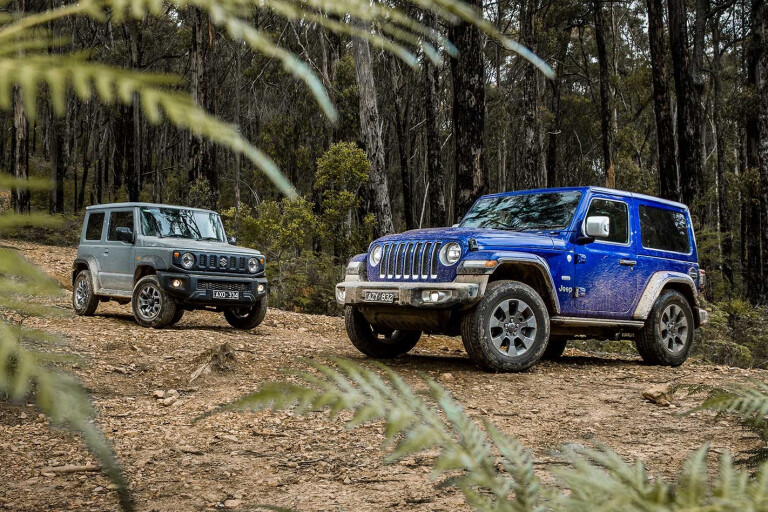
There was a time when all of our 4x4 vehicles were short wheelbase (SWB) two-door rigs and the ability to comfortably carry a family in the suburbs was never really a consideration. The original Jeeps, Land Cruisers, Patrols, Land Rovers, Suzuki 4x4s and even Range Rovers were all simple shorties, many of them with removable soft-tops.
Times have changed and shorties are now the exception to the rule, as passenger comfort takes precedence over off-road functionality. While we have more choices of 4WD vehicles now than at any other time in history, there are currently only two two-door SWB 4x4 wagons on sale in Australia: the Jeep Wrangler and the Suzuki Jimny.
Interestingly, both of these new-for-2019 models can trace their heritage back to the original models from their respective marques, and both of them carry over some styling features to pay homage to their forbears. But don’t be fooled, these are modern vehicles, and as such are a far cry from the utilitarian vehicles they were spawned from.
Let’s see how they line up…
Suzuki Jimny - Small Box
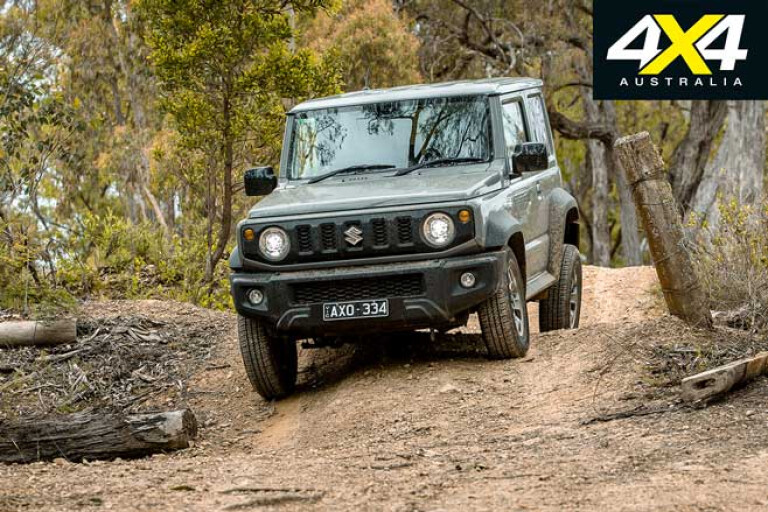
The Jimny returned to the Australian market early in 2019 as an all-new vehicle that was launched internationally a few months prior. The new Jimny is a descendant of the original Suzuki 4x4, the 1970s LJ10. The LJ10 progressed to the LJ20, LJ50, LJ80, Stockman and Sierra variants with soft- and hard-top bodies, short and long wheelbases and even a ute version, but it always stayed true to its simple and functional design roots.
The new Jimny is available in just one body style, one wheelbase and one model variant, albeit with the choice of automatic or manual transmissions. It retains the lovable boxy styling of its predecessors and hasn’t lost any of its off-road charm, either.
The Jimny starts at $23,990 (+ORC) when fitted with the manual gearbox, and you can add $2000 if you prefer an auto.
Powertrain & Performance

The Jimny’s one and only engine offering is a naturally aspirated 1.5-litre, petrol-fuelled four-cylinder, which makes just 75kW and 130Nm. While that doesn’t sound like much by today’s standards, it’s enough to comfortably get the lightweight Jimny up to highway speeds and over the steepest terrain. But there are plenty of times when your right foot is planted to the floor when accelerating or overtaking, and you wish the engine had a bit more poke. You need to plan any overtaking moves well ahead in a Jimny.
As mentioned there is a choice of stick-shift or auto transmissions and, like the Jimny’s styling, these are more retro than racy. The automatic has just four forward ratios, with fourth being an overdrive, while the manual, as tested here, offers five forward gears but top is one-to-one with no overdrive.

This is the shortcoming of the Suzuki’s powertrain as, while it gets up to speed swiftly, it’s left revving high and noisily at highway speeds where an overdrive would be more than appreciated. If you believe that just four gears in a modern transmission is acceptable, the auto Jimny is slightly better on the highway due to its taller overall gearing. But the Jimny is a made-for-fun fourby that encourages you to drive and use a manual gearbox.
The four-wheel drive system is a simple affair as well, with a part-time transfer case that includes low range, running out to open diffs in live axles front and rear. Electronic traction control is the only factory traction aid, so you’ll have to turn to the aftermarket for locking differentials.
On-road ride & Handling
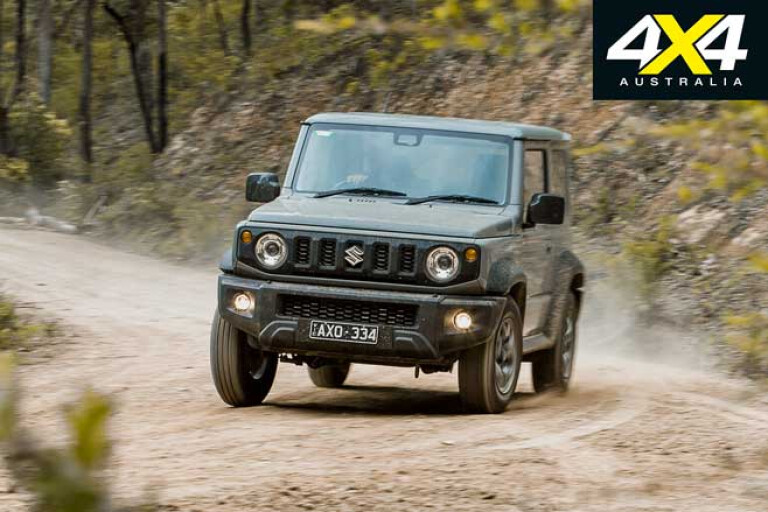
No matter how you look at a Jimny, it’s obviously a narrow track, tall-riding wagon rolling on live axles and skinny 80 aspect tyres; so it’s never going to be a scalpel-sharp corner carver. This is a traditional off-road vehicle, so fast corners need to be treated with due respect. That said, it can still be fun to pedal with some pace, particularly on gravel roads where the tyres have a bit more give.
The highway ride is surprisingly good. It’s no luxury car but it’s more comfortable and forgiving than you might expect, with none of the fore-aft pitching that was once a hallmark of shorties. Coil springs and a three-link setup are used to suspend the Jimny front and rear. The factory dampers feel like a compromise in all conditions, and we think the chassis would benefit greatly from a quality set of shocks.
Off-road

We should count our lucky stars that Suzuki opted to stay true to the Jimny’s design and heritage when it gave us this latest model. Car companies these days too easily opt for the soft option when bringing out a new model, and true off-road vehicles are getting harder to come by. Just look at Suzuki’s own Vitara, for example.
With its light weight, dual-range transmission, good ground clearance, excellent driver visibility, live axles and coil springs, the Jimny is a great little off-roader. We say little due to its diminutive size, and we doubt the Jimny will find many willing to drive it on an off-road lap of the country, but for a weekend play toy it hits the mark directly.
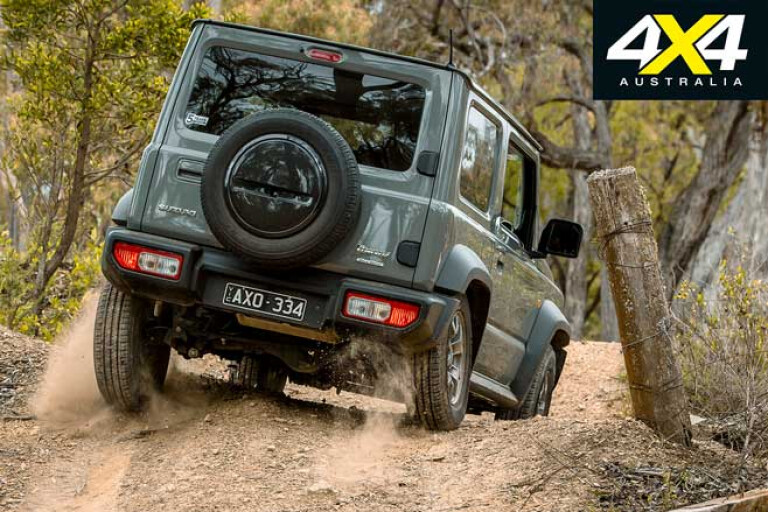
Of course, there’s always room for improvement. The relatively small 195/80R15 tyres tend to bounce over and drop into rocks and holes that larger, more common wheel sizes will just roll through. This creates a harsh and jolting off-road ride even with the tyre pressures dropped accordingly. Any increase in tyre size will benefit the Jimny in both off-road ride quality and capability. A little suspension lift using quality aftermarket springs and dampers wouldn’t hurt, either.
The factory electronic traction control works okay but is far from the latest and greatest version of this system. Some all-terrain or mud-terrain tyres would be the first step to improve traction, with aftermarket lockers being the ultimate.
Cabin & Accommodation
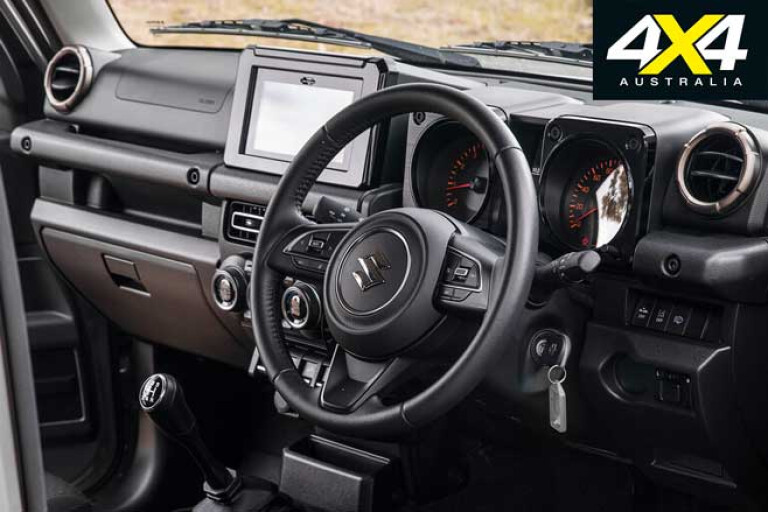
Despite its small overall dimensions, the interior of the Jimny offers a lot more space than you might think. From the driver’s point of view, the Suzuki offers more elbow, leg and headroom than the bigger all-over Jeep. That’s the beauty of putting things in boxes, it makes the most of any and all available space. Form follows function and all that.
The feeling of space within the Jimny is helped by the absence of some creature comforts. The console and drink holders are tiny, the small door pockets have no bottle holders, and the seats are relatively small when compared to other (bigger) vehicles. The flat windscreen and low door windows enhance the open-space feeling as well.
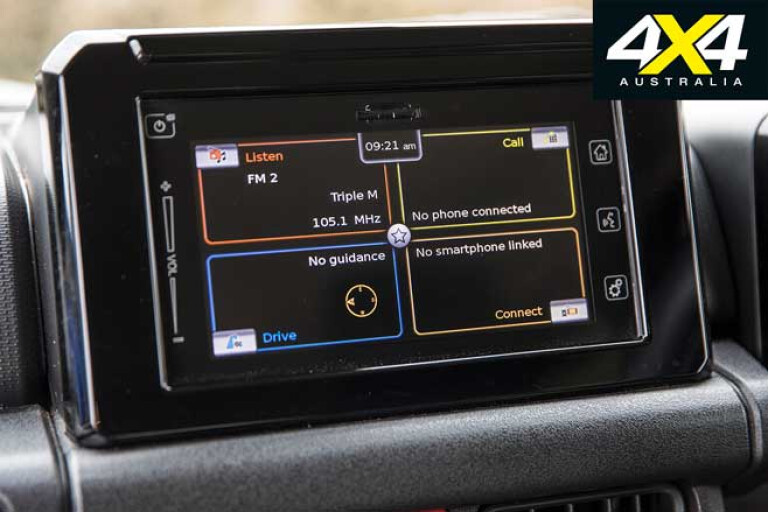
It’s not lacking anything you need. There are power windows and mirrors, single-zone climate-control air-conditioning, and a large A/V screen for satnav and audio functions. That screen becomes hard to read if you wear polarised glasses, a fault that few other vehicles seem to suffer.
The rear seat accommodation isn’t great and would be best kept for small kids on short trips; but, face it, you don’t buy a Jimny as a family car, so that back seat is best removed altogether to increase cargo space. The rear seat does split and fold individually but not totally flat, and removing it would open up a lot more usable space. With the seat upright there is very little cargo space behind it.
Practicalities
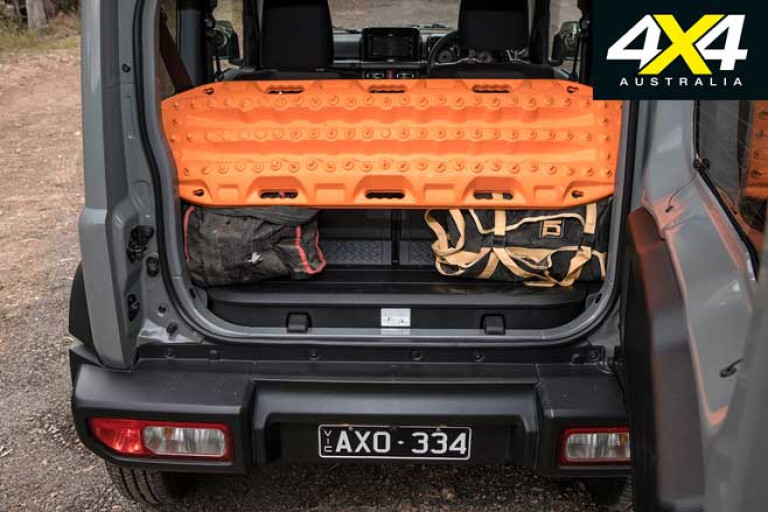
Size is everything when it comes to the practicalities of the Jimny, which is limited by its stature and capacity. A 1435kg GVM leaves you with around 340kg of payload. Towing is limited to 1300kg braked and 350kg unbraked. The 40-litre fuel tank is tiny and you’ll be looking for a fuel stop within 400km.
Seeing the worldwide popularity of the Jimny, the aftermarket has come to the party to help rectify many of its shortfalls, and there’s a growing list of equipment available to make it a better off-roader. Suspension, wheels, storage, bullbars and even supercharger and turbo kits are all available if you look for them.
Jeep Wrangler Overland - Pure & Simple
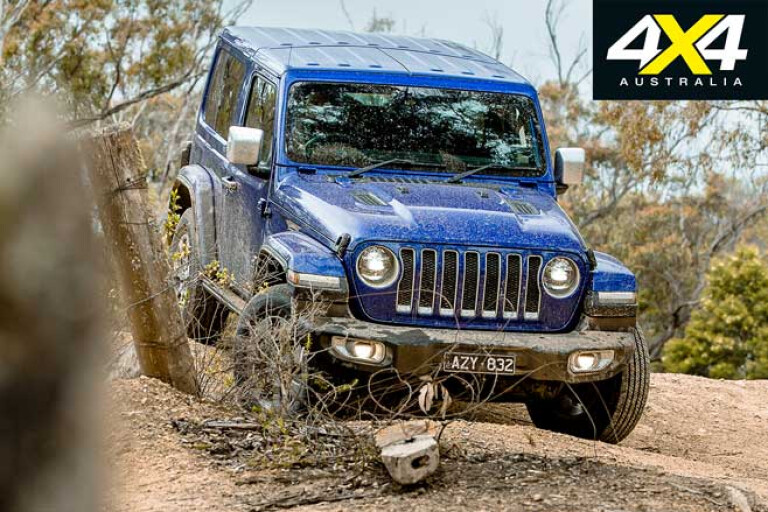
Jeep’s JL Wrangler line-up hit our shores not long after the Jimny did in the first part of 2019, and with it came the surprise that the traditional SWB two-door model would only be available in Sport S and Overland model grades, and only with the V6 petrol and eight-speed auto transmission powertrain. Significantly, this meant no off-road focused Rubicon shorty and no diesel engine or manual gearbox.
While this disappointed many purists, the Wrangler remains one of the best off-road wagons in showroom trim, and the JL ups the on-road ante over any Wrangler before it with improved refinement and features.
A Jeep Wrangler shorty will cost you $48,950 in Sport S trim level or $59,450 as an Overland as we have here.
Powertrain & Performance

Jeep’s 3.6-litre Pentastar V6 engine was considered state-of-the-art for petrol mills when it was introduced almost 10 years ago. It might be getting long in the tooth, but there’s nothing wrong with it and it feels like it has a new lease of life in the lighter JL Wrangler now that’s it’s backed by the excellent eight-speed auto.
The two-door JL Overland is 138kg lighter than the equivalent four-door model with the same powertrain, and this allows it to make the most of its 209kW and 347Nm. The ‘little’ Wrangler feels sporty by comparison as it willingly spins up in revs and shoots through the gears. Jeep’s claimed numbers put the shorty half a second ahead of the four-door in the zero to 100km/h dash. We can only imagine how much fun it would be if we could row through those gears with a manual ’box, but no such luck for us Aussies.
The eight-speed TorqueFlite auto built under licence from ZF helps the Pentastar achieve better fuel numbers as well as performance. The official ‘combined’ fuel economy figure is 9.6L/100km, so it can make the most of that 66-litre tank. The four-door Wrangler gets an 81-litre tank and claimed 9.7L/100km combined cycle.
On-road ride & Handling

The Wrangler is an overall bigger vehicle than the Jimny, and that affords it more suspension travel, bigger wheels and tyres, and hence better overall ride and handling. The Jeep still uses live axles front and rear, in its case suspended on a three-link front and five-link rear arrangement with coils.
The Overland’s 255/70R18 tyre size is a good compromise for both handling and ride. It is tall enough to give a smooth ride, while low enough to not move around too much when pushed hard. The Dueler H/T pattern is definitely aimed at on-road use.
With the JL model, the Wrangler moved to electrically assisted power steering, which is well suited to this type of vehicle. It delivers enough feedback to the driver at higher speeds yet offers plenty of assistance at low speeds, both when driving on tracks or when parking around town.
Off-road

Any Jeep Wrangler is a good off-road vehicle, and the short wheelbase variants are better than the long ones as they are easier to manoeuvre in tight spaces and have a far better ramp-over angle than the long wheelbase models. We didn’t experience any of the belly scraping with this Overland shorty that we have experienced with Rubicon-spec Unlimited JLs. It does, however, still suffer the poor departure angle of its longer brethren, and will scrape its back bumper on many exits.
Sure, the Overland doesn’t get all of the off-road hardware of the Rubicon, but its open diffs and electronic traction control will get it most places people will want to go.
In the absence of a SWB JL Rubicon, off-road enthusiasts wanting a shorty might be best off opting for an entry level Sport S and going wild with aftermarket gear. Like all non-USA-spec JLs, the Overland’s transfer case offers the choice of 2WD, full-time 4WD, locked 4WD high-range and locked 4WD low-range.
Cabin & Accommodation
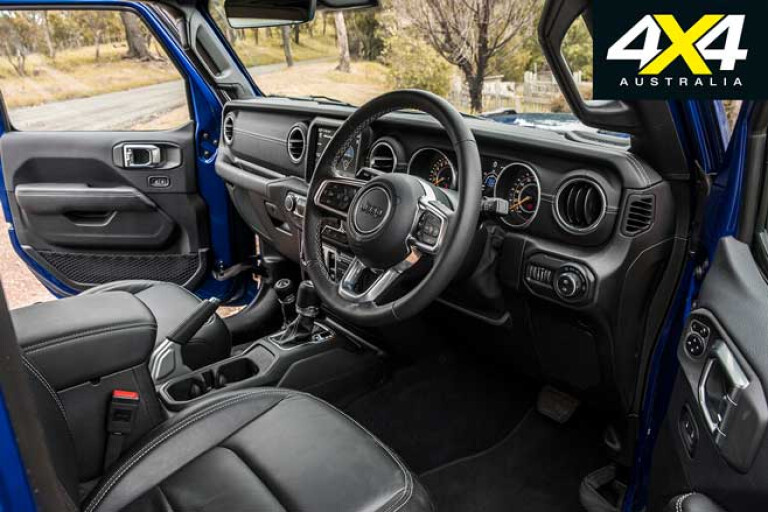
In Overland trim the JL interior is a nice place to ride. It’s comfortable, well-appointed and everything is easy to find and operate. It offers more space than the Jimny’s cabin but is still best suited to just two passengers. Again, we’d be throwing that rear seat to the rafters and maximising the Wrangler’s cargo space. Compared to Jimny, there’s also more space behind the rear seat when it is in use, but not a lot. The rear seat only folds in one piece.
The one big thing the Jeep offers that no other vehicle does is an open interior. Whether you simply remove the front roof panels or you have the time to completely remove the top, open-air motoring is what traditional four-wheel driving is all about. You can even fold the windscreen flat to the bonnet for a full flow-through cabin; there’s nothing else like it in this day and age.
It must be noted that only the Sport S specification in both two- and four-door comes standard with a soft-top, and only the two Rubicon models have the soft-top offered as an option. A hardtop is standard on Rubicon and is all that is offered on Overland variants.
Practicalities

With its extra size, capacity, refinement and comfort, the Wrangler is a lot more practical than the Jimny; but you would expect that at twice the price. Towing capacity for the shorty Jeep is 1497kg braked, while payload is a modest 551kg. As mentioned, the tyres are a sensible and practical size and a +1 upsize to all-terrain rubber will vastly improve your tyre choices and the vehicle’s off-road ability.
The Jeep Wrangler is the most accessorised four-wheel drive in the world, so you can get everything you need, and plenty that you don’t need, to modify your Wrangler to your desires. Wheels, tyres, snorkels, half doors, suspensions, complete axle assemblies, custom roofs, lights, engine conversions … the sky is the limit! Careful research into what you need to get the Jeep where you want to go will see you equip it to do anything.
Suzuki Jimny vs Jeep Wrangler Overland verdict - Get Shorty
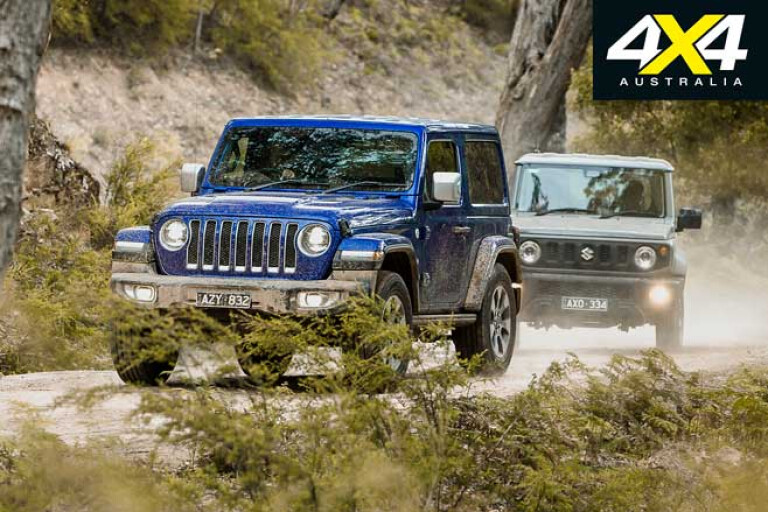
While their respective manufacturers have stuck to traditional off-road values in their design and construction philosophies, and these are the only two two-door 4x4 wagons you can buy at the moment, they are very different in many ways. Buyers might think they both look cute, but we doubt the Overland and the Jimny would attract the same buyer type.
Price has the most to do with this. You can buy two fully-kitted Jimnys for the cost of a Wrangler Overland, but the Suzuki will never be able to offer the comfort and refinement of the Jeep.
Of course, if you are after a soft-top your choice has been made for you. We reckon it’s criminal that Suzuki doesn’t offer a soft-top Jimny, especially when you consider the fun we had in older open-top Suzuki 4x4s. C’mon Suzuki, give us a soft-top … and a ute while you’re at it.

If the lack of a soft-top Suzuki can be considered a crime, then the absence of a SWB Wrangler Rubicon, or any Wrangler with a manual gearbox, should be a hangable offence.
Omissions such as these are taking the joy out of what should be fun fourbies made for enthusiasts. There are enough boring SUVs in the marketplace. Bring on the fun factor and option either of these little rippers correctly and you’ll find yourself driving miles of smiles.
Specifications
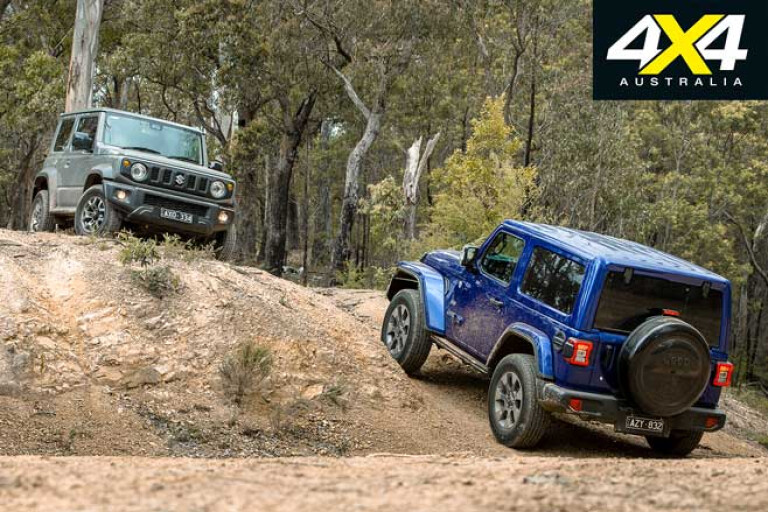
| Suzuki Jimny | Jeep Wrangler Overland | |
| Engine | 1462cc OHC petrol inline 4-cyl | 3604cc DOHC petrol V6 |
| Power | 75kW at 6000rpm | 209kW at 6400rpm |
| Torque | 130Nm at 4000rpm | 347Nm at 4100rpm |
| Gearbox | 5-speed manual | 8-speed automatic |
| 4x4 System | Part-time with 2WD (rear); locked 4x4 high and low | Part-time and full-time 4x4 w/ locked high and low range |
| Crawl Ratio | 36.23:1 | 44.2:1 |
| Construction | 3-door body on separate frame chassis | |
| Suspension (f) | 3-link leading with coil springs | |
| Suspension (r) | 3-link leading with coil springs | 5-link leading with coil springs |
| Wheel/tyre spec | Alloy/195/80R15 | Alloy/255/70R18 HT |
| Departure Angle | 49˚ | 29.2˚ |
| Rampover Angle | 28˚ | 26.2˚ |
| Approach Angle | 37˚ | 34.8˚ |
| Wading Depth | 300mm | 760mm |
| Ground Clearance | 210mm | 260mm |
| Kerb Weight | 1095kg | 1762kg |
| GVM | 1435kg | 2313kg |
| Payload | 340kg | 551kg |
| Towing capacity | 350/1300kg | 750/1497kg |
| Fuel capacity | 40 litres | 66 litres |
| ADR fuel claim | 6.4L/100km | 9.6L/100km |
| Test fuel use | 8.9L/100km | 10.6 litres/100km |



COMMENTS